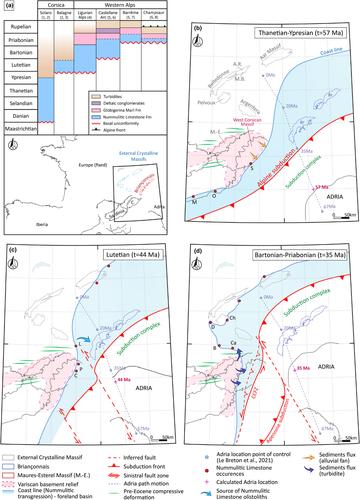当前位置:
X-MOL 学术
›
Basin Res.
›
论文详情
Our official English website, www.x-mol.net, welcomes your
feedback! (Note: you will need to create a separate account there.)
Sedimentology and structure of the Paleogene Nummulitic series of Corsica: Reconstruction of the southern termination of the western Alpine foreland basin
Basin Research ( IF 2.8 ) Pub Date : 2024-09-09 , DOI: 10.1111/bre.12898 Caroline Van de Vyver 1 , Cédric Carpentier 1 , Mary Ford 2 , Jaume Vergés 3 , Mihaela Melinte‐Dobrinescu 4
Basin Research ( IF 2.8 ) Pub Date : 2024-09-09 , DOI: 10.1111/bre.12898 Caroline Van de Vyver 1 , Cédric Carpentier 1 , Mary Ford 2 , Jaume Vergés 3 , Mihaela Melinte‐Dobrinescu 4
Affiliation

|
Nummulitic Limestones deposits are preserved along the tectonic contact between the Variscan basement and Alpine units of Corsica. These marine carbonates, dated from the Late Palaeocene to the Middle Eocene, were deposited within a foreland flexural basin that is considered to be the southern continuation of the Alpine foreland basin of southeast (SE) France. However, in contrast with the Nummulitic Limestones of SE France, those of Corsica are far less documented. This field‐based study constrains the sedimentology, stratigraphy and structure of the Nummulitic Limestones of Corsica in three localities (Balagne, Corte and Sari‐Solenzara) to identify factors that controlled foreland basin development and to clarify its significance within the early alpine orogen. The microfacies, microfaunal assemblages and siliciclastic fractions are characterised throughout the succession at each locality. The results indicate the existence of an important Variscan basement relief to the west of the basin (West Corsican Massif) that supplied early alluvial fans found at the base of the foreland succession in the northernmost Balagne area. Continuous high clastic input strongly reduced the development and diversity of the overlying Nummulitic Limestones facies and fauna. Further south, limestones in the Corte and Sari‐Solenzara areas are thicker and contain richer fauna. Three depositional models corresponding to the carbonate ramp system are proposed for the Nummulitic Limestones and used to construct paleogeographic maps illustrating the transgressive evolution of the Corsican foreland basin from the Early to the Late Eocene. Based on our results and available regional tectonic data and LT thermochronological data, we propose that the Nummulitic marine transgression took place within a continuous foreland basin encompassing southern Corsica and SE France during the early development of the western alpine arc.
中文翻译:

科西嘉岛古近纪钱币系列的沉积学和结构:西部高山前陆盆地南端的重建
钱币石灰岩沉积物沿瓦里西亚基底和科西嘉岛阿尔卑斯山单元之间的构造接触面保存下来。这些海相碳酸盐岩的年代为古新世晚期至始新世中期,沉积在前陆弯曲盆地内,该盆地被认为是法国东南部阿尔卑斯前陆盆地的南部延续。然而,与法国东南部的钱币石灰石相比,科西嘉岛的钱币石灰石的记录要少得多。这项基于实地的研究限制了科西嘉岛三个地点(Balagne、Corte 和 Sari-Solenzara)的泥石灰岩的沉积学、地层学和结构,以确定控制前陆盆地发育的因素,并阐明其在早期高山造山带中的重要性。微相、微动物组合和硅质碎屑组分在每个地点的整个演替过程中都有特征。结果表明,盆地西部(西科西嘉地块)存在重要的瓦里西亚基底地形,为最北巴拉涅地区前陆序列底部发现的早期冲积扇提供了物质来源。持续的高碎屑输入强烈降低了上覆的钱币灰岩相和动物群的发育和多样性。再往南,科尔特和萨里-索伦扎拉地区的石灰岩更厚,动物群也更丰富。针对钱币灰岩提出了与碳酸盐坡道系统相对应的三种沉积模型,并用于构建古地理图,说明科西嘉岛前陆盆地从早始新世到晚始新世的海侵演化。 根据我们的研究结果以及现有的区域构造数据和LT热年代学数据,我们提出,在西部高山弧的早期发展过程中,钱币海侵发生在包含科西嘉岛南部和法国东南部的连续前陆盆地内。
更新日期:2024-09-09
中文翻译:

科西嘉岛古近纪钱币系列的沉积学和结构:西部高山前陆盆地南端的重建
钱币石灰岩沉积物沿瓦里西亚基底和科西嘉岛阿尔卑斯山单元之间的构造接触面保存下来。这些海相碳酸盐岩的年代为古新世晚期至始新世中期,沉积在前陆弯曲盆地内,该盆地被认为是法国东南部阿尔卑斯前陆盆地的南部延续。然而,与法国东南部的钱币石灰石相比,科西嘉岛的钱币石灰石的记录要少得多。这项基于实地的研究限制了科西嘉岛三个地点(Balagne、Corte 和 Sari-Solenzara)的泥石灰岩的沉积学、地层学和结构,以确定控制前陆盆地发育的因素,并阐明其在早期高山造山带中的重要性。微相、微动物组合和硅质碎屑组分在每个地点的整个演替过程中都有特征。结果表明,盆地西部(西科西嘉地块)存在重要的瓦里西亚基底地形,为最北巴拉涅地区前陆序列底部发现的早期冲积扇提供了物质来源。持续的高碎屑输入强烈降低了上覆的钱币灰岩相和动物群的发育和多样性。再往南,科尔特和萨里-索伦扎拉地区的石灰岩更厚,动物群也更丰富。针对钱币灰岩提出了与碳酸盐坡道系统相对应的三种沉积模型,并用于构建古地理图,说明科西嘉岛前陆盆地从早始新世到晚始新世的海侵演化。 根据我们的研究结果以及现有的区域构造数据和LT热年代学数据,我们提出,在西部高山弧的早期发展过程中,钱币海侵发生在包含科西嘉岛南部和法国东南部的连续前陆盆地内。































 京公网安备 11010802027423号
京公网安备 11010802027423号